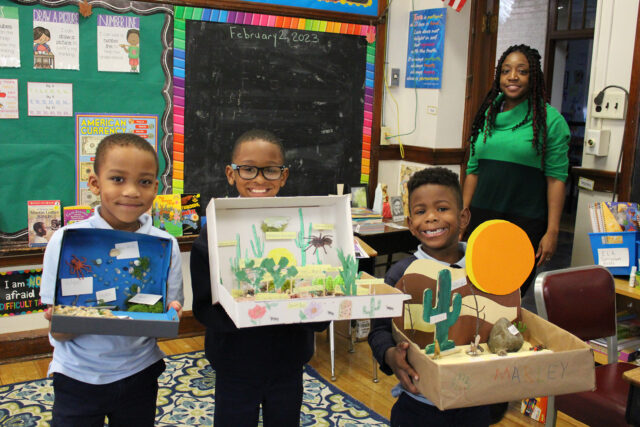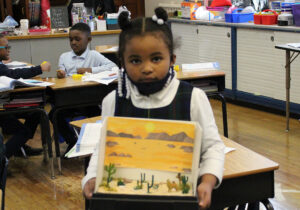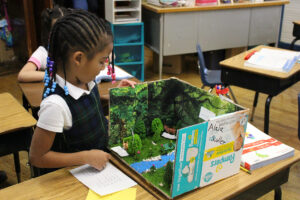
WILMINGTON — Nature has come to life at St. Peter Cathedral School, where the first grade recently learned some science in a fun, interactive way. The students, with the help of adults at home, made dioramas representing the habitats of their favorite animals.
Verneé Fryer, the first-grade teacher, wanted a hands-on project that would help her students understand better the living conditions most familiar to animal life. Each student picked an animal and were assigned to make a diorama — a replica of a scene, many times a small-scale reproduction — about the desert, the ocean, the forest or wetlands.
“I thought it would be fun,” Fryer said. “I thought it would be a more interesting way for them to learn instead of just using the textbooks. A lot of them do love science.”
Fryer said the students and their helpers got to work just before the Christmas break, and the dioramas began arriving shortly after they returned in January. Each one had to have more than three plants and more than three animals, and each had to be labeled. She sent parents and guardians links to resources online where they could learn more about what a diorama is.

One student picked a snake as his favorite animal, but Fryer said there are snakes in every habitat. So he tried again and went with a tarantula, which earned him the desert. Another student picked a dolphin, another a crab.
The students were enthusiastic about doing the diorama, which led to a welcome problem. The table placed outside the classroom to showcase the boys’ and girls’ projects was too small, so the school had to add another. It has proven to be a big draw.
“It’s fascinating. All the other kids, even the older kids, they come down and they look at them,” Fryer said.
As important as the knowledge the students gleaned about the animals was their work on the dioramas themselves, Fryer said. Project-based learning is very helpful with higher-order and critical thinking.
“It got me really excited because it’s something I wish I could have done in school. We never had an opportunity to do it,” she said.
A few students commented on doing the project. Jada Gibson had a desert diorama that included cacti and a lizard. She didn’t know there are different kinds of cactus.

“I learned about the animals and what’s in the desert,” she said.
Her classmate, Marley Brown, said his favorite part of the project was “that I got to go outside and find a rock.” He had help from an aunt and took a stab at gluing his animals in his desert diorama.
“I was gluing,” he said. “Then I burnt myself with a hot glue gun.”
Amari Bailey said he learned a lot about what lives in the ocean. He picked the crab as his favorite animal. “My dad helped me glue the animals on with hot glue, and my mom helped me label it.”
Spending some time with family was important to Fryer, as was having her students a little bit about doing research and developing those skills. She wants them to know how to look things up and “be independent thinkers, independent learners.
“I really want them to learn for them to be facilitators of their own learning, not just relying on me. I want them to be able to acquire the information on their own for themselves.”








